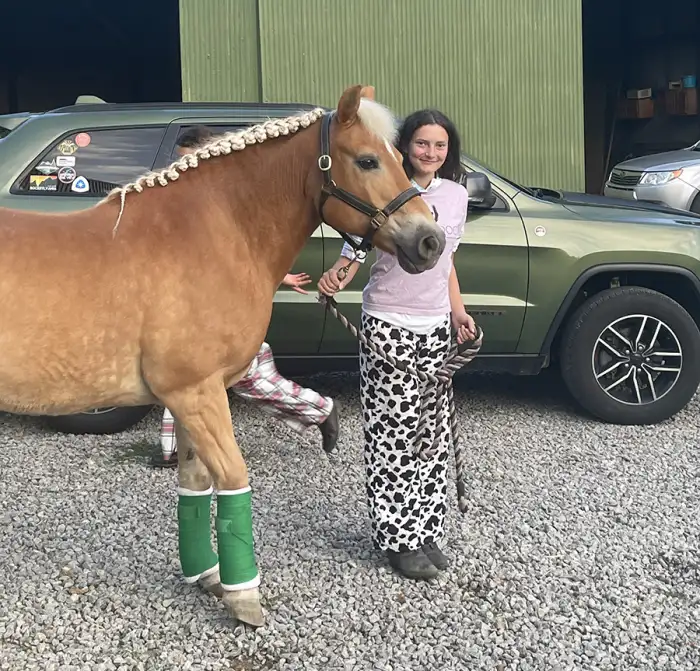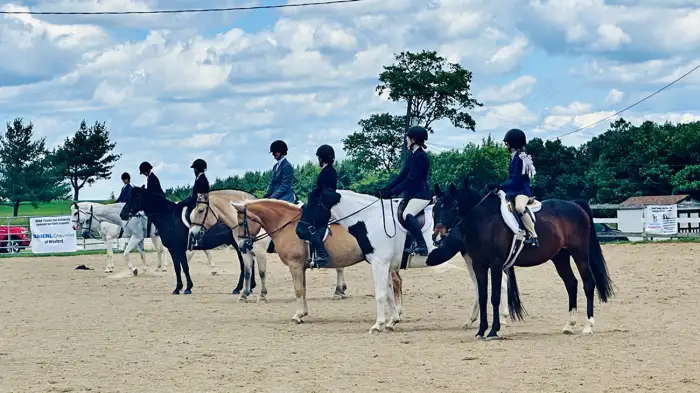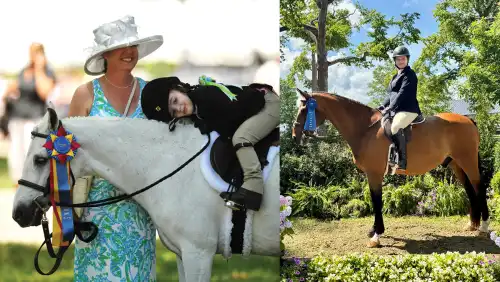I recently spent 12 hours at our 4-H district’s horse show with our lesson program’s show team. It was the last of the season, and today I’m nursing a severe horse show hangover. When my alarm went off this morning at 5:15 a.m. for my “real job,” it felt like the middle of the night, and I am counting down the hours until I can be in sweatpants on my couch. But as I reflect on the year—our program’s first year taking students to shows on our farm’s school horses—my heart is full thinking about how far our riders have come and all they’ve learned.
When I opened Black Dog Stables in 2018, showing wasn’t on my radar. I loved teaching the basics to new riders as a side hustle, and I was happy to move them on to nearby stables with larger programs when they learned all that I could teach. But my program grew quickly, and I brought on another instructor, Meagan Greygor of Nonpareil Equine Services, to help share the load. Meagan, now a dear friend, is our lead instructor, teaching the bulk of the lesson load, so I can focus on the stables’ educational programs and my toddler son.
And Meagan, it turned out, had horse show aspirations for our riders, so I climbed on board—albeit a little hesitantly—for the ride.

I showed a lot as a kid, mostly at open shows held at the little arena in the local county park, and through 4-H. I didn’t have a fancy, expensive horse, and I didn’t ride at a big barns with well-known trainers. I was in the ribbons maybe half the time; I had good equitation, but my horse wasn’t ever going to top any English pleasure class. I remember shows being political even before I really knew what that meant. I remember witnessing abusive “training techniques” in the warm-up ring that resulted in winning rides, and I felt angry and helpless. By the time I graduated from high school, I was happy to leave the horse show world behind.
But then I discovered IHSA in college and competed for the next three years. Riding IHSA, with an excellent team of coaches and horses, was a highlight of my collegiate career and the foundation of my hunter/jumper education.
After college, I bounced around a bit: a year teaching in Virginia, a year nannying in England, then a year in Philadelphia for grad school. I took lessons with the University of Pennsylvania’s equestrian team, but between full-time student teaching and graduate coursework, showing didn’t fit in my schedule. And as a grad student and alumni rider, I didn’t feel “part of the team” like I did as an undergrad.
I was two decades removed from the show ring when Meagan and I hosted our first schooling show on the farm, for our lesson students only, held after a week of camp with a “So You Want to Horse Show?” theme. Riders tucked “Inaugural Horse Show” barn-logo T-shirts into khaki breeches or jodhpurs and trotted over ground rails or circled the outdoor in a little flat class with one or two other students. My friend Julie judged, talking to the riders in each class before awarding ribbons, complimenting each student on aspects of their riding that she liked and offering each a suggestion for what to work on in upcoming lessons.
The show went over exceptionally well, and parents and students alike wanted to know when we’d do it again. Meagan had been tossing around the idea of taking interested students off the property, and the enthusiasm after that first home show inspired her to research local options and set some plans in stone for 2024.
So this year, for the first time, we took a handful of our lesson horses and students off the farm to attend some local school-horse-friendly competitions. Coach Meagan was in charge. Meagan printed pre-show to-do lists for each rider, handwriting each a good-luck message on the back. Insisting that riders prep their own horses and equipment, Meagan spent long days at the barn before each show, supervising tack cleaning and trailer packing and horse bathing, and showing her students the correct way to tame manes and clip hairy Haflinger legs. My jobs: drive trailer, wipe boots at the in-gate, give kids pep talks, and explain to parents what on earth is going on.

I loved watching Meagan teach and coach and guide her students. I loved watching my cherished horses take care of our new competitors. And when some of my little four-legged darlings demonstrated a little more spunk or spook than they might at home, I loved seeing our students overcome fears or nerves to step up and ride.
It’s been a real joy watching our students experience the world of horse showing for the first time, learning so many of the timeless life lessons that only this sport is able to teach:
ADVERTISEMENT
Horse showing teaches hard work.
As they prepped for each show—conditioning leather and stuffing hay bags and scrubbing poop stains off the world’s grossest Paint again—our students learned that just making it to the gate is a lot of work. By the time our riders are through their show-prep checklists, they’re tired, they’re sopping wet, there is hay in places it shouldn’t be, and their alarms are set for far earlier than a school day. But they all trudge, yawning, into the barn the next morning, at it again: picking hooves and brushing out tails and scrubbing off new poop stains (how does it get up under your sheet, Dakota?), proud to show off their horses and their hard work to the judge.
Horse showing teaches commitment and responsibility.
It doesn’t matter who invited you to a party, or what high school teams are playing football games, because if you have a horse show the next day, there’s work to be done, and you’ll be at the barn until it’s finished. And even after the show is over, the work isn’t. Our students come back to the barn to care for the horse they rode, hosing or currying their mount, refilling water buckets and tossing hay, putting away tack and helping empty the trailer. By the end of the season, our students were working together in their post-show fog, checking on the horses and helping each other get all the jobs done.

Horse showing teaches independence, self-confidence and leadership.
When it comes down to it, even if coaches or parents are watching from the rail, when you’re showing a horse it’s just you and your mount in the arena together. And when something unexpected happens—a gust of wind blows the banner on the food booth, or a loose horse gallops past a flat class, for example—there isn’t time to look to elsewhere for guidance. Riders have to learn to make split-second decisions on their own. At the beginning of the season, our students looked to Meagan for so much:
Pony won’t back in the lineup? Coach! What do I do?
Horse won’t trot because he’s frozen in his tracks, fascinated by the hackney pony in the warm-up ring? Coach! What do I do?
Judge announces a pattern in an equitation class? OMG Coach! What do I do?
But now, with even just a handful of shows under their belts, our riders are learning to be leaders and to trust their own decision-making. There are fewer panicked, questioning eyes directed at Meagan and I, and more confident riders, making quick choices in the best interests of themselves and their mounts.

Horse showing teaches that life isn’t fair, and s**t happens, literally.
One of our lesson horses is an adorable, sometimes stubborn little Halflinger named Bear. The previous show, Bear trucked around the arena like a furry little tank, and he and his rider won both their equitation and under saddle flat classes. But perhaps he was nervous at districts, or perhaps he gorged himself on hay in the hour trailer ride to the show ring, because in his first class, he pooped. Twice. And when Bear poops, Bear doesn’t move. You can kick him, tap him with a crop, cluck, beg, negotiate, promise him endless treats after the class—it doesn’t matter. Bear isn’t going until he’s done going. His rider left the arena teary-eyed—they’d had a lovely ride, otherwise, and rode a nice little equitation pattern—and she was disappointed at their unlucky timing (the judge giggled sympathetically when she saw him do his business). But after Meagan and I shared stories of our own unlucky horse shows we were soon laughing, all three of us. Sometimes s**t happens, but it was a beautiful day with horses and friends, and in the grand scheme of things, that’s pretty lucky in and of itself.
ADVERTISEMENT
Horse showing teaches riders to set goals.
We remind our riders regularly that when you go to a horse show, you are literally paying for someone’s opinion of you, your horse, and your riding. We reinforce to our riders that if that opinion, and the ribbon that accompanies it, are all that matters, your priorities and focus are out of whack. Before each show, we ask our riders for their goals for the day. Maybe it’s to land all their diagonals. Maybe it’s to keep their horse straight between jumps. Maybe it’s consistency in their gaits. Maybe it’s to remember to keep their eyes or thumbs up or lower leg back. And if those goals are met, no matter what ribbons may or may not be added to their bedroom wall at the end of the day—if this ride was in any way better than the last—the day should be counted as a success.

And showing teaches that sometimes, goals need adjusted on the fly.
When Waffles, our most-seasoned show horse, decided that a monster was hiding in the porta-potties right outside the show ring, his rider had to pivot. Rather than attempting to execute a perfectly polished ride, her new goal was to sit up, stay on, keep Waffles as focused and calm as possible, and make the most of her time in the ring. The pair didn’t place that class, but she came out beaming and petting Waffles for being a good boy. And perhaps the focus and confidence instilled in that the experience led to their reserve-champion finish at the next show.
And showing SHOULD teach us that no matter what, the horse comes first.
At districts, we had a long break between classes. Our horses were stalled and Meagan, our students, and I sprawled out on wool coolers on the grass outside of one of the arenas. After a little while of watching jumping rides, one of our students said dramatically, “I’m going to check on Dakota. It’s been for-ev-er since I’ve checked on him, and I want to make sure he’s OK.”
That same student, over the Labor Day weekend (knowing the barn was closed) sent me a text: “If Dakota isn’t doing anything this weekend, would you like me to come out and groom him, or give him a bath?” Of course, I’d said, and was thrilled that before she left the barn, in addition to bathing Dakota and hand-grazing him in the sun to dry, she’d also swept the barn and filled his water bucket and hay net. When I complimented her, she blushed and said, “It’s no big deal; I just saw that it needed done.” Horse showing taught her to look around, pay attention to details, and take initiative to do what’s best for your horse.
And when Waffles suffered a late-season tendon injury, he had to go on stall rest and his rider couldn’t show at districts. Despite her disappointment, when she came to the barn for her next lesson, I found her in his stall, stroking his neck and talking to him. “I’m just glad that we know what’s wrong with him, and that we can let him rest and get better,” she told me.
On the ride back to the barn from the district show, Meagan and I chatted about what worked this season, what we’d adjust for next, and what our own goals are for the future. We’re both excited to introduce more of our students to the show ring, so that they can grow as riders, and as people, from the lessons it has to teach.
So despite the fact that I’m stumbling through this post-show day in a fog, I’m grateful for the opportunities that Meagan has given our students this year, and I’m grateful to be a part of the experience. I’ll just be stopping for an afternoon coffee on the way home.
Sarah K. Susa is the owner of Black Dog Stables just north of Pittsburgh, where she resides with her husband and young son. She has a B.A. in English and Creative Writing from Allegheny College and an M.Ed. from The University of Pennsylvania. She teaches high school English full-time, teaches riding lessons and facilitates educational programs at Black Dog Stables, and has no idea what you mean by the concept of free time.














